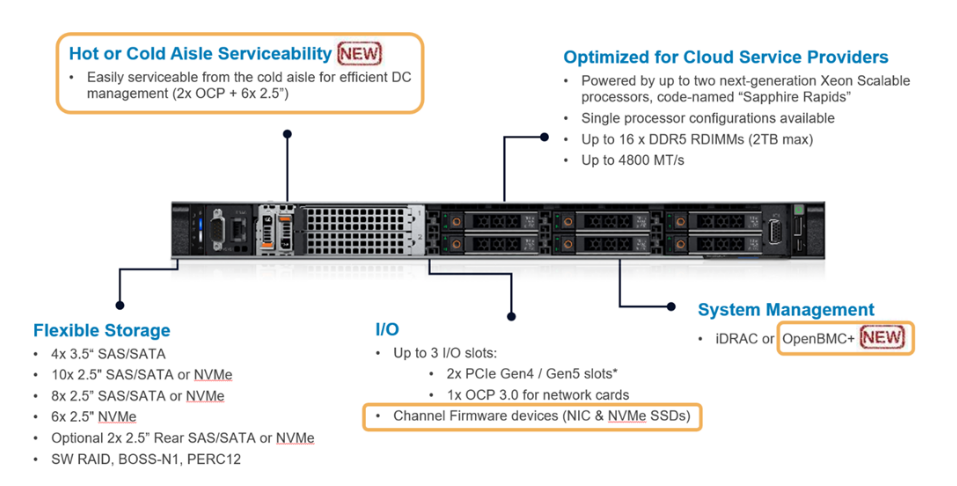Efficient data management is crucial for businesses to stay competitive. A major aspect of this efficiency lies in the server and storage hardware. Dell PowerEdge, one of the industry-leading solutions, offers a game-changing built-in storage feature that is specifically designed to optimise performance.
In this blog post, we will delve into the benefits of Dell PowerEdge’s built-in storage, with a focus on its appropriately sized S2D configuration.
Understanding Dell PowerEdge’s Built-in Storage
Overview of Dell PowerEdge server and storage hardware
When it comes to server and storage solutions, Dell PowerEdge stands out as a market leader. Designed to meet the demanding needs of businesses of all sizes, Dell PowerEdge servers offer exceptional performance, reliability, and scalability. Combined with built-in storage capabilities, Dell PowerEdge empowers businesses to manage and store their valuable data efficiently.
Exploring the concept of built-in storage and its advantages
Traditional storage solutions often require separate hardware components, leading to additional costs and complexities.
Dell PowerEdge’s built-in storage feature integrates storage controllers directly into the server, eliminating the need for external components and streamlining data management. This integration offers several advantages, including reduced latency, improved data accessibility, enhanced fault tolerance, and simplified maintenance processes.
Highlighting the importance of appropriately sized S2D configuration
A critical component of Dell PowerEdge’s built-in storage solution is the appropriately sized Storage Spaces Direct (S2D) configuration.
S2D leverages the power of software-defined storage to pool together the internal drives of multiple servers, creating a highly available and scalable storage system. It is essential to properly size the S2D configuration based on specific business needs to unlock the full potential of Dell PowerEdge’s built-in storage capabilities.
Unveiling the Benefits of Dell PowerEdge’s Built-in Storage
Enhanced data accessibility and scalability
Video courtesy of @DellTechnologies via YouTube Videos.
By leveraging Dell PowerEdge’s built-in storage, businesses can achieve improved data accessibility. The elimination of external storage components reduces network latency, enabling faster data retrieval and processing.
Additionally, the scalable nature of Dell PowerEdge allows businesses to expand their storage capacity as their data demands grow seamlessly.
Simplified management and maintenance processes
The integration of storage controllers within Dell PowerEdge servers simplifies data management and maintenance processes. System administrators can utilise a single interface to monitor and manage both server and storage components, reducing the complexity and time required for maintenance tasks. This unified approach also enhances the overall system stability and reliability.
Maximised performance and reduced latency
With Dell PowerEdge’s built-in storage, businesses can expect maximised performance and reduced latency. The direct integration of storage controllers eliminates the need for data to travel through external components, reducing latency and improving overall system responsiveness. This optimised performance allows businesses to access and process data, boosting productivity and efficiency quickly.
Improved fault tolerance and data protection
Dell PowerEdge’s built-in storage feature enhances fault tolerance and data protection through its S2D configuration. The pooling of drives across multiple servers creates redundant copies of data, providing improved fault tolerance. In the event of a server failure, data is automatically shifted to the remaining servers, ensuring continuity and reducing the risk of data loss.
Embracing the Appropriately Sized S2D Configuration
Unpacking the concept of S2D (Storage Spaces Direct) configuration
Storage Spaces Direct (S2D) is a software-defined storage solution offered by Dell PowerEdge. It utilises internal server drives to create a highly available and scalable storage system. S2D aggregates these drives across multiple servers to pool storage resources into a unified namespace, streamlining data management and improving performance.
Evaluating the optimal storage capacity for your specific needs
Properly sizing the S2D configuration is crucial to meet your specific storage needs. Determining the optimal storage capacity involves assessing data growth rates, current storage needs, and anticipated future requirements. Collaborating with experts can help you identify the right configuration that aligns with your data storage goals and accommodates future scalability.
Analysing the benefits of appropriately sizing the S2D configuration
An appropriately sized S2D configuration brings several benefits to businesses.
- Firstly, it ensures efficient utilisation of available resources, avoiding over-provisioning or underutilisation.
- Secondly, properly sizing the configuration enhances performance by optimising data distribution across servers.
- Moreover, an optimised S2D configuration allows businesses to scale their storage capacity seamlessly, adapting to changing data demands.
Implementation and Best Practices
Steps to effectively implement Dell PowerEdge’s built-in storage with S2D configuration:
Video courtesy of @DellTechnologies via YouTube Videos.
- Assess your storage requirements and evaluate the anticipated growth.
- Consult with Dell PowerEdge experts to determine the appropriate S2D configuration for your business.
- Procure the Dell PowerEdge servers with built-in storage capabilities.
- Deploy the servers and configure the S2D setup, ensuring fault tolerance and data redundancy.
- Test and verify the functionality and performance of the S2D configuration.
- Maintain regular monitoring and updates to ensure optimal performance and reliability.
Exploring best practices for maximising performance and reliability
- Regularly monitor and optimise storage performance metrics, such as latency and throughput.
- Implement a robust backup and disaster recovery strategy to safeguard critical data.
- Stay updated with firmware and driver updates provided by Dell PowerEdge to ensure system stability and security.
- Engage in proactive maintenance, including regular disk health checks and monitoring system alerts.
- Consider leveraging Dell PowerEdge management tools and resources to streamline ongoing management and maintenance tasks.
Considerations for future scalability and expansion
As data demands continue to grow, scalability becomes a critical factor for businesses.
When implementing Dell PowerEdge’s built-in storage with properly sized S2D configuration, it is essential to consider future scalability. Assessing scalability requirements during the initial planning phase ensures that businesses can seamlessly expand their storage capacity without disruptions or costly migrations.
Conclusion
Conclusively, Dell PowerEdge’s built-in storage provides a comprehensive solution for efficient data management, especially when combined with an appropriately sized S2D configuration. The technology enhances accessibility, scalability, performance, and fault tolerance, empowering organisations to handle growing data demands effectively.
By adopting this technology and following best practices, businesses can stay ahead in the ever-evolving digital landscape and unlock their true potential.
FAQ Corner
What is Dell PowerEdge’s built-in storage feature, and how does it benefit businesses?
Dell PowerEdge’s built-in storage feature integrates storage controllers directly into the server, eliminating the need for external components and streamlining data management. This integration offers several advantages, including reduced latency, improved data accessibility, enhanced fault tolerance, and simplified maintenance processes.
How does properly sizing the Storage Spaces Direct (S2D) configuration unlock the full potential of Dell PowerEdge’s built-in storage capabilities?
An appropriately sized S2D configuration brings several benefits to businesses, such as efficient utilisation of available resources, optimised performance, seamless scalability, and adaptability to changing data demands.
What are some best practices for maximising performance and reliability with Dell PowerEdge’s built-in storage and S2D configuration?
Some best practices for maximising performance and reliability include:
- Regularly monitoring and optimising storage performance metrics.
- Implementing a robust backup and disaster recovery strategy.
- Keeping up with firmware and driver updates.
- Engaging in proactive maintenance.
- Leveraging Dell PowerEdge management tools and resources for streamlined management and maintenance tasks.
How can businesses effectively implement Dell PowerEdge’s built-in storage with S2D configuration?
Businesses can implement Dell PowerEdge’s built-in storage by assessing their storage requirements, consulting with Dell PowerEdge experts, procuring the appropriate servers, deploying and configuring the S2D setup, testing and verifying its functionality and performance, and maintaining regular monitoring and updates to ensure optimal performance and reliability.
Why is scalability an essential consideration when implementing Dell PowerEdge’s built-in storage with an appropriately sized S2D configuration?
Scalability becomes a critical factor for businesses as data demands continue to grow. Assessing scalability requirements during the initial planning phase ensures that businesses can seamlessly expand their storage capacity without disruptions or costly migrations.
Are you ready to unlock the full potential of your data management with Dell PowerEdge’s built-in storage?
Transform your business and stay one step ahead of the competition with efficient data management. Dell PowerEdge’s built-in storage offers game-changing benefits such as enhanced data accessibility, scalability, simplified management, maximised performance, and improved fault tolerance.
Don’t miss out on this opportunity to optimise your data management and unleash the true potential of your business. Embrace the power of Dell PowerEdge’s built-in storage and take the first step towards elevating your data management strategy.
Reach out to our experts today and let us help you navigate the world of efficiently managed data.




